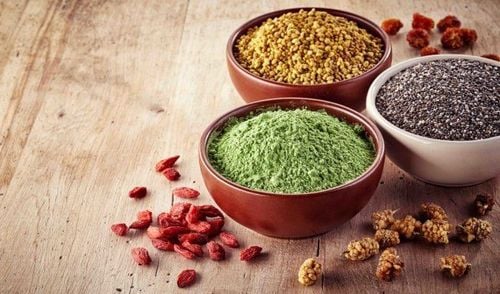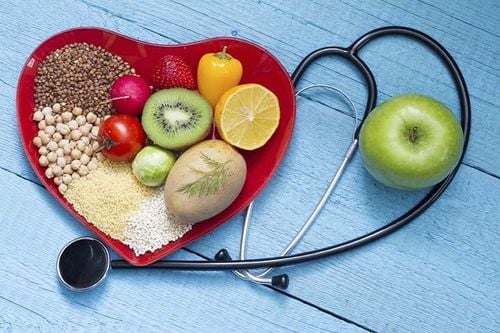This is an automatically translated article.
Fiber is an indispensable food group in the daily menu, not only for better digestion, fiber also provides many other great benefits for your body. The recommended fiber requirement for Vietnamese people is at least 20-25g/person/day. Note that when eating foods with fiber, you need to drink a lot of water or liquid to help push fiber through the intestines easily.
1. What is fiber?
Fiber is a component of foods of plant origin that cannot be digested by the body. Fiber consists of carbohydrate molecules (monosaccharides or polysaccharides) and is divided into 2 types:
Soluble fiber is a substance that can be dissolved in liquid into the intestinal tract in the form of a gel. Found in leafy vegetables, fruits with high viscosity (jute, spinach...) and some legumes (soybeans, beans). Insoluble fiber: In contrast to soluble fiber, insoluble fiber is a substance that does not dissolve with fluids when entering the intestinal tract. It can be metabolically inert and provides an expectorant or presynaptic, fermentative metabolism in the large intestine. Swelling fibers absorb water as they move through the digestive system, soothing bowel movements. Insoluble fiber tends to speed up the movement of food through the digestive system. Food sources of insoluble fiber include the hulls of foods (wheat, brown rice, whole barley, and some) vegetables, tubers, fruits).
Trắc nghiệm dành riêng cho người mắc đái tháo đường: Chế độ ăn của bạn đã hợp lý chưa?
Người bị bệnh đái tháo đường cần phải quan tâm nhiều hơn đến cách tính toán khẩu phần ăn sao cho phù hợp với nhu cầu và tình trạng sức khỏe. Nếu chưa rõ, bạn có thể tìm hiểu kỹ hơn thông qua bài trắc nghiệm ngắn sau đây.2. The benefits of fiber
Soluble fiber creates a feeling of fullness for a long time to help prevent overweight, obesity, diarrhea and gastrointestinal disorders caused by bacteria, and at the same time contributes to reducing cholesterol in the blood.
Soluble fiber is also food for beneficial bacteria in the intestines, binds with bile acids in the intestine, reduces the emulsification of fats in food (makes it easier to digest), osmosis, and binds cholesterol. and remove them from the body.
Insoluble fiber helps limit the rise of blood sugar after eating in diabetics, prevention of high blood cholesterol and prevention of rectal cancer. When entering the intestinal tract, insoluble fiber helps to build up stool mass, stimulates the rectum to work gently, and prevents constipation.
Like soluble fiber, insoluble fiber also contributes to water retention when food is moved, increases the ability of bacteria to ferment in the large intestine, and prevents the absorption of toxins in food. ...

Chất xơ tan tạo cảm giác no lâu giúp ngăn ngừa thừa cân, béo phì
3. The role of fiber in the body
3.1 Nutrition for the body Most foods containing a lot of fiber are very good for the body. Example: Vegetables, fruits, cereals
3.2 Support the digestive process, prevent constipation When entering the intestines, fiber can absorb a lot of water, increase the volume of stools and stimulate intestinal motility. contract to expel stool. From there, helping to have regular bowel movements every day, the body expels toxins regularly and avoids absorbing toxins from feces into the blood.
Fiber helps regulate intestinal flora: Certain types of bacteria living in the intestines have the ability to break down and assimilate fiber. Dietary fiber supports the growth of beneficial bacteria. Thanks to the effect of regulating the microflora in the intestine, fiber also plays a role in promoting digestion and absorption in the intestine.
3.3 Lowers blood cholesterol The synthesis of bile salts is done in the liver with cholesterol as the raw material, then the bile salts are poured into the small intestine through the common bile duct. In the intestines, the water-absorbing fiber will expand to help keep bile salts in the mucous layers and then push the stool out, thereby reducing the reabsorption of bile salts. Therefore, a diet high in fiber will help lower blood cholesterol levels.
3.4 Fiber with Cardiovascular Disease High cholesterol in the blood is the cause of a number of cardiovascular diseases. Fiber helps lower cholesterol by reducing LDL fat and increasing HDL, thereby reducing the risk of cardiovascular diseases such as cholesterol, coronary heart disease, and atherosclerosis.
3.5 Losing weight Overweight and obese people often eat a lot, especially foods containing a lot of oil and fat. Therefore, excess energy accumulates in the body causing obesity. High-fiber foods are low in fat, making them ideal for people who want to lose weight. Foods rich in fiber take longer to chew, are not digested and absorbed in the stomach, often make people full and full for a long time, thus reducing appetite, preventing overweight and obesity.

Chất xơ giúp giảm thiểu nguy cơ các bệnh tim mạch
3.6 Participates in blood sugar regulation Fiber has the effect of making starch stay longer in the stomach, creating a feeling of fullness for a long time and slowing down the process of breaking down and absorbing glucose, causing blood sugar to rise slowly, without increasing Sudden blood sugar regulation. Therefore, people with diabetes should increase foods high in fiber in their daily diet.
3.7 Fiber with cancer Currently, many studies have shown the role of fiber in reducing the risk of colon cancer through beneficial bacteria in the intestine that produce substances that inhibit the growth of colon cancer. growth of cancer cells and helps to increase the excretion of potentially cancerous substances from the body. In addition, scientists also found the effect of fiber on reducing the risk of breast cancer by reducing the amount of estrogen in the blood.
Please dial HOTLINE for more information or register for an appointment HERE. Download MyVinmec app to make appointments faster and to manage your bookings easily.
Article referenced source: National Institute of Nutrition












